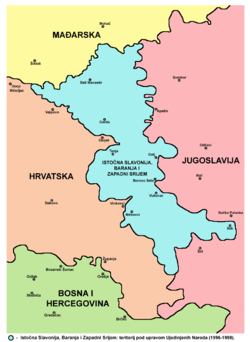Eastern Slavonia, Baranja and Western Syrmia (1995-1998)
| Eastern Slavonia, Baranja and Western Syrmia | ||||||||||
|
Istočna Slavonija, Baranja i Zapadni Srem Источна Славонија, Барања и Западни Срем |
||||||||||
| Self-proclaimed entity | ||||||||||
|
||||||||||
| Capital | Vukovar | |||||||||
| Government | Republic | |||||||||
| Chairman | ||||||||||
| • | 1995–1996 | Borislav Držajić | ||||||||
| President | ||||||||||
| • | 1995–1996 | Slavko Dokmanović | ||||||||
| • | 1996–1998 | Goran Hadžić | ||||||||
| Historical era | Breakup of Yugoslavia | |||||||||
| • | Collapse of the RSK | August 1995 | ||||||||
| • | UNTAES administration | 15 January 1996 | ||||||||
| • | Reintegrated into Croatia | 15 January 1998 | ||||||||
| Area | 2,600 km2 (1,000 sq mi) | |||||||||
| Currency |
Krajina dinar de jure Yugoslav dinar de facto Deutsche Mark de facto |
|||||||||
|
||||||||||
Eastern Slavonia, Baranja and Western Syrmia (Serbo-Croatian: Istočna Slavonija, Baranja i Zapadni Srem/ Источна Славонија, Барања и Западни Срем) was a short-lived Serb parallel entity in the territory of Croatia. It encompassed the same territory as the SAO Eastern Slavonia, Baranja and Western Syrmia formed in 1990, which had been merged into the Republic of Serbian Krajina. When the latter entity was dissolved with the end of the Croatian War of Independence in 1995, this territory remained in place for another three years.
After the Erdut Agreement, the territory was reintegrated into Croatia within UN peacekeeping mission UNTAES. The Joint Council of Municipalities, a sui generis inter-municipal legal body created during the process of reintegration, aligns the interests of the Serb community in the area.
Eastern Salvonia, Baranja, and Western Syrmia was formed out of the only part of the rebel Republic of Serbian Krajina (RSK) that was not overrun by Croatian government forces in August 1995. After Operation Storm in August 1995, by which the majority of the Republic of Serbian Krajina was restored to Croatian control, Eastern Slavonia, Baranja and Western Syrmia became a de facto self-governing territory. Immediately upon completion of Operation Storm, U.S. President Bill Clinton, within the framework of an initiative to end the war in Bosnia, said that there must be "...a long-term plan for a sustainable solution to the situation in Eastern Slavonia ... based on Croatian sovereignty and the principles outlined in the Z-4 plan". Croatia in this period hesitated between a diplomatic or military solution, but due to strong pressure from the international community, the possibility of military intervention was rejected. In November 1995, local Serb leaders signed the Erdut Agreement, by which the eventual re-integration of this region into Croatia was agreed-upon. The Erdut agreement was reached as part of negotiations at the Dayton Agreement conference. Nevertheless, the Croatian negotiating team has not accepted the Z-4 plan proposed by President Bill Clinton as a basis for negotiations.
...
Wikipedia



